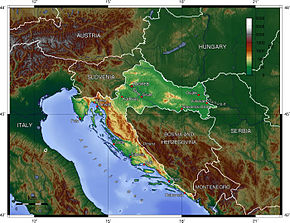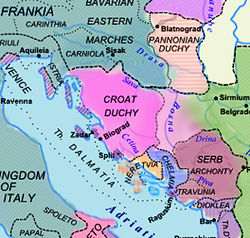Directory talk:Croatia
Notes
- Byzantines-Eastern Roman Empire (i.e. Procopius-Byzantine scholar, Jordanes- 6th century Roman bureaucrat) c. 550 Σκλαβῖνοι- Sklabenoi
- Latin: Sclaveni
- Hrvat in medieval times was pronounced "Harvat or Hrovat". Harvat/Hrovati was translated to Latin: Chroatorum and then simplified to Croatorum.
- Discovered In 1853 Χορούαθ[ος], Χοροάθος, Χορόαθος- Horoúathos, Horoáthos, and Horóathos (originally 3rd century AD-Tanais Tablets)
- Branimir's inscription c. 880: Croatorum (Latin)
- Baska tablet c.1100 AD: HR'VAT'SKI
Modern Croatian: Hrvatska
Chakavian Slavs
Old Chakavian Speaking Slavs By Peter Zuvela (rough draft)
What is missing in historic interpretations of the Southern Eastern European lands is the fact they mostly ignore the Roman Latin-Illyrian population (this especially applies to the 19th & 20th century). It is all about ones nationalism and the mythology that it is built around. We need to take into account that the old Chakavian Slavic speakers were the ancestors of the Croatian tribes who invaded and settled in a land of predominantly Roman Latin-Illyrian population. The Roman-Illyrian genes have survived to this day which means they did not disappear.
Additionally also it has to be taken into account that different Slavic tribes who arrived started mixing with other Slavic tribes as well as with the Roman Latin-Illyrian population. With that we can start to get a more accurate picture of what happened in the past (at least in my eyes).
Croatian tribes (old Chakavian Slavic speakers) must have arrived in the former province of the Roman Empire, Dalmatia during the mid 700s (8th Century AD) and made the Dalmatian hinterland their home. One group then ended up as far west as Histri (modern: Istria) and another ended up eastward as far as Montenegro.
There are no contemporary written records of the Slavic-Croatian tribes (Chakavian-Slavic speakers) invasion/migration/settlement or about the events as a whole within the area itself. It is quite possible that the area had a drop in population (due to wars i.e. Frankish-Avar wars) and also due to the lack of a military presence of the Byzantine Empire (aka Eastern Roman Empire, please note they referred to themselves as 'Empire of the Romans' Latin: Imperium Romanum).
Also the military presence of the Carolingian Empire was minimal or even non-existent at that time. This would have lead to an easy invasion of the area (opportunity beckons). The Roman Latin-Illyrian population as well as Liburnians, Greeks and others would have to had have endure the arrival of the Sclaveni (Slavs).
It is quiet possible that the success of the Croatian-Slavic tribes set the precedent for the Kajkavian-Slavic speakers and Shtokavian-Slavic speakers to follow suit.
The first written records of Slavic-Croatians started in the late 8th (as Slavs first) and early 9th century. I believe one of the reasons was that the Croatian tribes started to become western Europeanised (becoming part of the European Community rather than being isolated in the Dalmatian Hinterland). Within the Dalmatian Ducatus of the Carolingian Empire (812) certain Croatian leaders became the political elite and took political leadership. In order to maintain this they became Christians thus connecting with the Roman Church (via the Carolingian Empire, the Dalmatian Roman City States i.e. Spalatum, modern Split and the Republic of Venice). Military alliances and trade with neighbors where created, etc. In terms of language Croatian Slavic Chakavian became Lingua Franca of the inland area and started to replace Latin Dalmatian (Romance). It has been written that within the Court of Duke Trpimir (dux Trepimerus/Trepime) two languages were spoken. One Slavic based and the other Latin based.
With this, after a long period of time, the mainland was mostly Slavicized. The Roman population during the medieval times survived within the coastal cities, on the islands and in the inhospitable Dinaric Alps.
With this all happening the Carolingian Empire (as well as others) thought it to be a good idea to work as much as possible with the new arrivals Sclaveni-Croatorum, for their own vested interest, in this now frontier country ('borderland').
It is interesting to note at the Regnum Chroatorum (Kingdom of Croatia 925–1102 AD, Croatian: Hrvatsko Kraljevstvo) didn’t incorporate the Chakavian Slavic speakers (Croatian tribes) further south east down the Adriatic coast.
Their fate took a different historic course.
Around the river Neratva a group of Chakavian-Slavic (Narrentanos Sclavos) speakers took on the mighty Maritime Republic of Venice, independently. The Narentines (firstly known as Arentanoi) where first mentioned in the 9th century when the Republic of Venice recorded that Narrentanos Sclavos or Narentines, who are referred to in modern times as mainly Neretva pirates (Neretvani), started to disrupt Venice's trade with the east (Levant). It was established that they the newly arrived Sclavos (Slavs) had strategically secured the delta of the river Neretva and some of the islands as well as other surrounding areas in southern Dalmatia. It took many decades before Venice could minimise the threat from the Narentines (Slavic) pirates. It was doge Pietro II Orseolo who defeated the Narentines for the Republic of Venice in the year 1000.
Further south Croatian Slavs (at a later stage, 12 century onwards) started to become part of the Maritime State of Ragusa. If you look at the Republic of Ragusa ethnic history from a modern perspective (with out nationalism) with it’s main city Dubrovnik (originally called Ragusa) this became a community of mixed ethnicity. It is my firm belief that a very small community of Croats (Chakavian Slavic speakers) were the first Slavs to become part the Republic. By the time the Ragusain community started to write the Slavic language it was in an Shtokavian-Slavic form (not Chakavian Slavic). This to me indicates a Serbian influence. So a clear claim of pure Croatian (or Serbian) heritage is out of the question but rather a shared one (all be it with a strong Croatian presence).
There must have been a language shift with the Republic of Ragusa’s neighbors, within the Hercegovina area. There is a very strong probability that the eastern Chakavian-Slavic tribes and Shtokavian-Slavic speakers started to mix. The end result that was the Shtokavian-Slavic language became the Lingua Franca within the eastern part of Old Roman Dalmatia (thus begins the Shtokavian-Slavic language move westward). As a result, with time the Latin Dalmatian (Romance) language also disappears from the southern hinterland.
Other, new medieval states were created. These medieval states were Zahumlje, Travunia, and Duklja. They within a short time span came under heavy political influence of Raška (later Kingdom of Serbia). Serbian Nobles became a powerful political and military influence in that region, which lasted until the Kingdom of Serbia was conquered by the Ottoman Empire.
In these times within written records there is very little written about ethnicity but rather its all about the dux or leaders of the lands.
The first of these was duke, Borne.
The Our People Issue
The Naši meaning 'Our People' or our own kind.
• Naš jezik meaning our language.
Sir John Gardner Wilkinson mentions it in 1848
Classify "languages" versus "dialects,"
Western Roman Catholic church and
Eastern Orthodox
Takat to roll
The Our People
The Naši meaning 'Our People' or our own kind.
- Naš jezik meaning our language.
Sir John Gardner Wilkinson mentions it in 1848: Naski [1]
Chronology
- Prehistoric Croatia
- Illyrians tribes
- Roman Empire
- Ostrogoth Kingdom
- Carolingian Empire
- Kingdom of Croatia (925–1102)
With time one of the Slavic tribes within Dalmatian Ducatus of the Carolingian Empire became the political elite and the leaders (dux) of the province. It goes independent ......
Historic Croatia
then became part of ..... Kingdom of Hungary or Regnum Hungariae Some time after it lost its independents, the state Kingdom of Croatia (Regnum Chroatorum) in 1102, the political power within the Provence was transferred from Northern Dalmatia (no permanent seat. Nin, Klis, Bijaci and Knin) to the city of Zagreb, further inland (Zagreb was a Roman town of Andautonia). Zagreb today is the capital of modern Croatia.
Note: Harvat/Hrovati had there own province, the diplomatic name of the kingdom was "Kingdom of Croatia and Dalmatia" (Latin: Regnum Croatiae et Dalmatiae). Common Croatian language form of the name was Hrvatska Zemlja (Croatian country or 'Croatian land').
- Habsburg Monarchy - Austro Hungarian Empire
(Republic of Venice & Ottoman-Turkish Croatia)
- Yugoslavia
- Republic of Croatia
Habsburg Monarchy - Austro Hungarian Empire
Croatian territory under Habsburg rule was reduced to about 20,000 km².
Under Habsburg Monarchy
- we have Kingdom of Croatia
- then expanded Kingdom of Croatia-Slavonia
Yugoslavia
- During the history of Yugoslavia we have the Banovina of Croatia & Socialist Republic of Croatia.
These provinces incorporated Austro Hungarian Empire's old Kingdom of Dalmatia which included Republic of Ragusa's (Dubrovnik) old territory.
This means further territorial expansion to the current Croatia.

